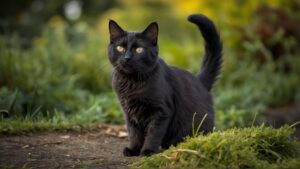Have you ever encountered Cat Breeds With No Tails and found yourself completely captivated by its unique appearance? From the iconic Manx to the rare and exotic Mekong Bobtail, tailless cats have a way of sparking curiosity and wonder in even the most seasoned feline enthusiasts.
While the absence of a tail may seem like a peculiar trait, these remarkable felines are the result of genetic mutations or selective breeding practices that have given rise to a diverse array of breeds, each with its own fascinating history, personality, and physical attributes.
Imagine a world where domestic cats sport the wild and exotic looks of their big cat cousins, or where ancient legends and folklore come to life in the form of these tailless wonders. From the rugged coasts of the British Isles to the lush jungles of Southeast Asia, these extraordinary felines have captured the hearts of cat lovers worldwide with their unique charm and endearing quirks.
In this comprehensive guide, we’ll embark on a journey through the enchanting realm of tailless cat breeds, exploring their origins, appearances, temperaments, and care requirements. Whether you’re a seasoned cat owner or simply a curious admirer, prepare to be captivated by the incredible diversity and allure of these one-of-a-kind felines.
So, let’s dive in and discover the top 11 cat breeds with no tails, from the beloved Manx to the lesser-known marvels that are sure to steal your heart. Get ready to experience the magic of these tailless wonders and embrace the world of feline fascination like never before!
Table of Contents
Discover the Unique Cat Breeds With No Tails
Are you fascinated by the adorable and unique cat breeds with no tails? Explore the world of tailless felines, from the famous Manx to lesser-known varieties, and learn about their charming personalities, origins, and distinctive features. This comprehensive guide delves into the top 11 cat breeds with no tails, providing insights into their history, grooming needs, and suitability as pets.
1. The Iconic Manx Cat
The Manx cat is undoubtedly the most well-known and iconic tailless breed, originating from the Isle of Man. Their history is steeped in folklore, with tales of their taillessness ranging from encounters with mermaids to the biblical story of Noah’s Ark.
Appearance: The Manx has a stocky build, rounded hindquarters, and a distinctive rabbit-like hop. Their coat can be found in various colors and patterns.
Personality: Intelligent, playful, and affectionate, Manx cats are loyal companions forming strong bonds with their owners.
Grooming & Health: Low-maintenance coat but may be prone to spinal deformities or digestive issues due to the genetic mutation causing taillessness.
2. Mekong Bobtail
The Mekong Bobtail is a rare breed originating from the Mekong River region in Southeast Asia, with a distinctly wild appearance.
Origins: Discovered in the 1990s, descended from semi-feral domestic cats adapted to the region.
Appearance: Muscular body, short or absent tail, and a wild look with a wedge-shaped head and striking eyes.
Temperament: Loyal, active, and adaptable, thriving in both indoor and outdoor environments.
Care: Regular grooming, balanced diet, and plenty of exercise and mental stimulation.
3. Pixie-Bob Cat
The Pixie-Bob was developed in the United States to resemble a wild bobcat, with a unique appearance and personality.
Origins: Established in the 1980s from a brown-spotted cat named Pixie, bred with domestic cats to create the distinct bobcat-like traits.
Appearance: Muscular build, broad head, and a distinctive short or kinked tail. Coats can be found in various colors and spotted markings.
Personality: Intelligent, devoted, and energetic, forming strong bonds with owners and thriving on interactive play.
Care: Low-maintenance coat but requires plenty of exercise, toys, and opportunities for climbing and jumping.
4. Cymric Cat
The Cymric is a semi-long-haired variety of the Manx breed, known for its tailless appearance and fluffy coat.
Appearance: Shares the stocky build and rounded hindquarters of the Manx, with a longer, semi-long coat.
Personality: Similar to the Manx, intelligent, playful, and affectionate.
Grooming: Requires regular brushing to maintain the longer coat and prevent matting.
Care: Similar to the Manx, may be prone to spinal deformities or digestive issues due to the genetic mutation.
5. Eurasian Lynx
The Eurasian Lynx is a relatively new breed, originating from a cross between the Siberian and other domestic cats.
Appearance: Muscular build, with a short, stumpy tail or no tail at all.
Personality: Intelligent and affectionate, with a strong hunting instinct.
Grooming: Requires regular brushing to maintain their coat.
Care: Provide plenty of interactive play and environmental enrichment to satisfy their hunting instincts.
6. Highlander Cat
Developed in the United States, the Highlander is a medium-sized breed with a muscular body and a short or missing tail.
Appearance: Muscular build, short or missing tail, and a variety of coat colors and patterns.
Personality: Known for their intelligence and affectionate personalities.
Grooming: Regular brushing and grooming depending on coat length.
Care: Provide mental stimulation through interactive play and training.
7. Karelian Bobtail Cat
Originating from the Karelian region of Russia, this breed is known for its distinctive short, kinked tail or complete lack of a tail.
Appearance: Sturdy build, semi-long water-resistant coat, and a short or absent tail.
Personality: Independent and intelligent, with a strong hunting instinct.
Grooming: Requires regular brushing and grooming to maintain their semi-long coat.
Care: Provide plenty of environmental enrichment and opportunities for climbing and jumping.
8. Kurilian Bobtail Longhair Cat
This breed is a long-haired variety of the Kurilian Bobtail, originating from the Kuril Islands.
Appearance: Semi-long coat, short or absent kinked tail, and a striking appearance.
Personality: Intelligent, active, and loyal companions.
Grooming: Requires regular brushing and grooming to maintain their long coat.
Care: Provide plenty of interactive play and environmental enrichment.
9. The American Bobtail Cat
Developed in the 1960s, this breed has a distinctive short tail or absence of a tail, combined with a muscular body.
Appearance: Muscular body, short or absent tail, and a wide range of coat colors and patterns.
Personality: Known for their loving and affectionate personalities, as well as their intelligence and adaptability.
Grooming: Grooming requirements vary based on coat length.
Care: Provide mental stimulation through interactive play and puzzle feeders.
10. Canadian Lynx
As the name suggests, this breed was developed in Canada to resemble the wild lynx.
Appearance: Medium-sized body, short or absent tail, and a distinctive tufted ear appearance.
Personality: Intelligent, active, and curious, with a strong hunting instinct.
Grooming: Requires regular brushing and grooming to maintain their coat.
Care: Provide plenty of environmental enrichment and opportunities for climbing and jumping.
11. Japanese Bobtail Cat
This ancient breed is recognized by its unique bobbed tail, which is often carried upright or curved over the back.
Appearance: Muscular build, bobbed tail carried upright or curved over the back, and a variety of coat colors and patterns.
Personality: Intelligent, loyal, and affectionate companions.
Grooming: Requires regular brushing and grooming depending on coat length.
Care: Provide mental stimulation through interactive play and training.
The Genetics Behind Tailless Cats
The absence of a tail in certain cat breeds is the result of a genetic mutation or selective breeding practices. Understanding the genetics behind tailless cats can provide valuable insights into their development and potential health implications.
Exploring the Genetic Mutation Responsible for Taillessness Many tailless breeds carry a genetic mutation known as the “Manx gene,” affecting the development of the vertebrae and spinal cord during embryonic growth. This can result in varying degrees of taillessness or shortened tails.
Differences Between Tailless and Short-tailed Cats It’s important to distinguish between tailless breeds like the Manx and those with naturally short tails, such as the American Bobtail or Kurilian Bobtail. Short-tailed breeds often have a distinct kinked or curved tail but not the same genetic mutation as tailless breeds.
Potential Health Implications While taillessness is generally harmless, cats with the homozygous form of the Manx gene may be at higher risk of developing spinal deformities, such as spina bifida or sacral spinal cord abnormalities, leading to mobility problems or incontinence. Responsible breeding practices and genetic testing are crucial.
Caring for a Tailless Cat
Tailless cats share many similarities with tailed cats in terms of care, but there are some unique considerations:
Grooming and Hygiene Regular brushing is recommended, and owners may need to assist with cleaning around the hindquarters due to the absence of a tail.
Environmental Enrichment and Playtime Many tailless breeds are highly energetic and playful, requiring ample environmental enrichment through interactive toys, scratching posts, and puzzle feeders, as well as regular playtime and exercise.
Diet and Nutrition Tailless cats have similar nutritional requirements as other domestic cats, but their unique genetic makeup and potential health concerns may require dietary adjustments. Consulting a veterinarian or feline nutritionist can help determine the appropriate diet and supplements.
Addressing Health Concerns Regular veterinary check-ups and monitoring are essential to catch and address any potential health issues early on, such as spinal deformities or mobility problems.
Tailless Cats as Companions: Pros and Cons
Advantages
- Distinctive appearance
- Affectionate and loyal personalities
- Adaptability to various living situations
- Low-maintenance grooming for some breeds
- Unique genetic history
Potential Challenges
- Health concerns related to genetic mutations
- Rarity and availability of some breeds
- Higher initial cost for rare breeds
- Potential behavioral issues
- Grooming assistance required around hindquarters
Finding a Reputable Breeder or Rescue Organization When acquiring a tailless cat breed, it’s essential to find a reputable breeder or rescue organization that prioritizes ethical breeding practices and the well-being of the cats. Responsible breeders should provide genetic testing, health certifications, and detailed information about the breed’s history and temperament.
FAQs
Are tailless cats prone to any specific health issues?
Tailless breeds carrying the Manx gene mutation may be predisposed to certain health issues, such as spinal deformities, mobility problems, or incontinence. Regular veterinary check-ups and responsible breeding practices are crucial.
Do tailless cats have balance issues due to the lack of a tail?
Tailless cats have adapted to the absence of a tail and generally do not experience significant balance issues, but they may have a distinct rabbit-like hop or gait.
Are tailless cats hypoallergenic?
No, tailless cats are not considered hypoallergenic. They produce the same allergens as tailed cats, and individuals with cat allergies may still experience reactions.
Do tailless cats require special care or accommodations?
While tailless cats share many care requirements with tailed cats, they may require assistance with grooming and hygiene around their hindquarters. Additionally, providing environmental enrichment and addressing potential health concerns related to their genetic mutations is essential.
Are tailless cats recognized by major cat associations?
Yes, most major cat associations, such as the Cat Fanciers’ Association (CFA) and The International Cat Association (TICA), recognize and have breed standards for various tailless cat breeds, including the Manx, Cymric, and Japanese Bobtail.
By exploring the unique characteristics, personalities, and care requirements of these 11 tailless cat breeds, you can better understand the fascinating world of felines without tails and determine if one of these breeds might be the perfect companion for your lifestyle.




